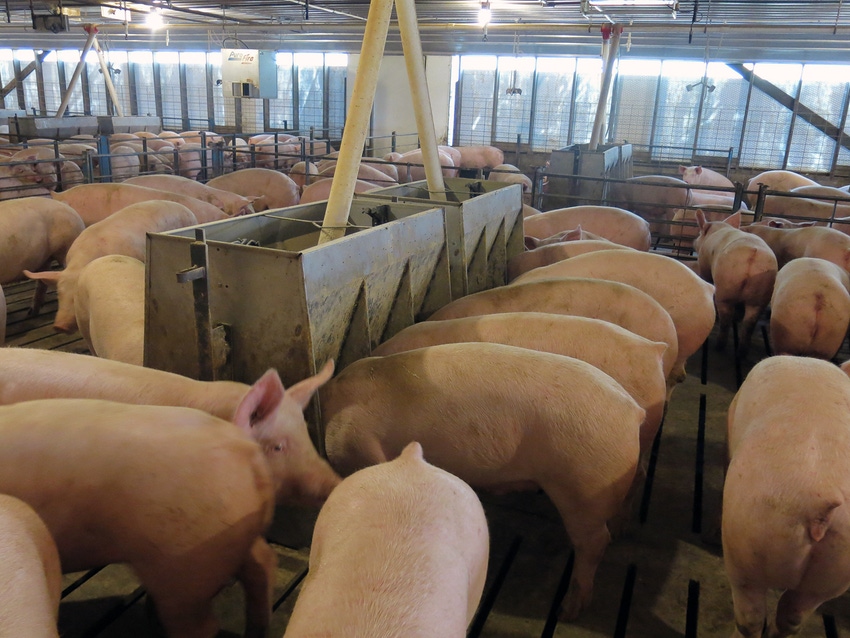As the marketing weight of finisher pigs continues to increase in the United States, so does the need for further investigation of the most cost effective finisher pig production practices.
August 3, 2017

By Ryan Samuel, South Dakota State University assistant professor and Extension swine specialist; and Joseph Darrington, South Dakota State University assistant professor and Extension specialist-livestock environment engineer
Cost-effective pork production relies on the efficient conversion of feed to pork. Furthermore, the revenue from any particular site is effectively constrained by the available finisher pig floor space.
In order to maximize the site production, pens are stocked to maximize floor space utilization, in accordance with the designed number of animals per pen. However, because currently available floor space per pig and nutrient recommendations are based on considerably lighter market weight pigs, it raises the question of whether these recommendations require revision. Researchers from Kansas State University recently reviewed the available literature for pigs marketed at weights greater than 285 pounds. They observed that as finisher pig floor space became limiting, feed intake was reduced, thus restraining growth. They also concluded that the nutrient requirements for pigs greater than 300 pounds require investigation (Wu et al., 2017).
Recently, we performed a trial at the South Dakota State University wean-to-finish commercial research unit to investigate the effects of individual floor space allocation on feed conversion and overall performance of pigs from 230 pounds to heavy weight finishers over 300 pounds. Pigs were provided free access to water and mash diets throughout the trial. Diets were based on corn and soybean meal and formulated to meet or exceed nutrient requirements in two phases: 1) 220 to 265 pounds providing 0.57% digestible lysine and 2) 265 to 310 pounds providing 0.48% digestible lysine.
The maximum daily outdoor temperatures observed during the trial were 64 degrees F in February, 68 degrees F in March and 69 degrees F in April. The monthly average temperatures observed during the trial were 29.8 degrees F in February, 31.6 degrees F in March and 46 degrees F in April. (SD Mesonet Archive — Flandreau site)
Three floor space per pig allocations were tested: 9.8, 8.3 and 6.8 ft2 per pig. The standard gate position provided 9.8 ft2 per pig, so floor space per pig was adjusted by moving the pen gates back from the standard position 3 and 6 feet, respectively. Pens were stocked with 23 pigs per pen to begin the trial and all removals and treatments were documented. Pen weights were measured using a pen scale every week. Feed remaining was quantified by measuring the feed in the feeders before weighing the pens each period.
In contrast to the KSU review, weekly feed disappearance per pig was not affected by floor space allocation in this trial (Table 1). Similarly, the mean body weights of pigs were not different between treatments at the beginning of the trial or any subsequent period. As a result, feed conversion efficiency was not changed by the pen space treatments.

Table 1: Weekly performance of finisher pigs housed with 6.8, 8.3 or 9.8 square feet per pig
Pigs were marketed when the average weight of pigs in the barn reached 300 pounds. The heaviest five pigs from each pen were marketed in a first and a second cut one week apart before the remaining pigs were marketed in the third week. Marketing was balanced between treatments, which resulted in pigs raised with 6.8 ft2 per pig tending to be lighter at marketing in the first and second cut than those raised with 9.8 ft2 per pig. However, there was no difference in body weight between the floor space allocations when the final group was marketed. Carcass lean percent tended to be greater from pigs provided 6.8 ft2 per pig of floor space, thus improving the carcass value of those animals compared to pigs provided 9.8 ft2 per pig (Table 2). These results seem to support the conclusion that the nutrient requirements of pigs greater than 300 pounds require investigation.

Table 2: Carcass lean percent, carcass value, and carcass weight of marketed finisher pigs housed with 6.8, 8.3 or 9.8 square feet per pig
With a nod to The Muppet Show “Pigs in Space” crew of the Swinetrek as they investigated the galaxy, we continue to investigate the effects of finisher pig floor space allocation on feed conversion and overall performance. As the marketing weight of finisher pigs continues to increase in the United States, so does the need for further investigation of the most cost effective finisher pig production practices.
References
Gonyou, H.W. and W.R. Stricklin. 1998. Effects of floor area allowance and group size on the productivity of growing/finishing pigs. J Anim Sci. 76:1326-30.
Wu, F., K.R. Vierck, J.M. DeRouchey, T.G. O’Quinn, M.D. Tokach, R.D. Goodband, S.S. Dritz and J.C. Woodworth. 2017. A review of heavy weight market pigs: status of knowledge and future needs assessment. Transl. Anim. Sci. 1: 1-15
You May Also Like



